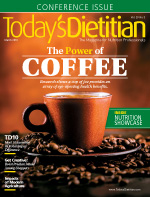 March 2018 Issue
March 2018 Issue
Ask the Expert: The Calories In, Calories Out Diet
By Toby Amidor, MS, RD, CDN
Today's Dietitian
Vol. 20, No. 3, P. 10
Q: What is the Calories In, Calories Out (CICO) diet, and is it effective for weight loss?
A: The CICO diet is based on the simplified concept that creating a calorie deficit in the body—that is, consuming fewer calories than one burns—results in weight loss. CICO discussions have gone viral on social media websites such as Reddit, and the diet concept is drawing a following. However, this fad diet—as with all fad diets—has pros and cons and can be a mixed bag regarding weight loss and getting adequate nutrition.
The Diet
The concept behind the CICO diet is that the food you choose to eat doesn't matter; rather, the number of calories consumed is key to weight loss. This thinking stems from the statistic that 1 lb of fat is equal to 3,500 kcal. As such, theoretically, if one consumes 500 kcal fewer than she burns each day of the week, then after one week she should lose 1 lb of fat (500 kcal X 7 = 3,500 kcal). The foods chosen are irrelevant, making all calories "equal." For example, the calories in an orange are perceived the same way as the calories in a candy bar.
Benefits
The CICO diet entails counting calories of everything consumed. Many nutrition professionals discuss the importance of tracking calories consumed with clients, and there's scientific evidence supporting this weight loss tactic. A 2011 systematic review published in the Journal of the American Dietetic Association looked at the relationship between weight loss and self-monitoring strategies such as a paper diary or mobile app. Researchers found a consistent and significant association between self-monitoring and weight loss.1
Drawbacks
Several cons exist when following the CICO diet. First and foremost, when nutrient composition of foods isn't taken into account, insufficiencies and, in the long term, deficiencies can result. The 2015–2020 Dietary Guidelines for Americans pinpoint the underconsumed nutrients in the American diet, including vitamin D, potassium, fiber, and calcium. Overlooking nutrient composition in a weight loss plan can lead dieters to continue consuming inadequate levels of essential nutrients. Furthermore, the Dietary Guidelines data reveal that three-quarters of Americans have a diet low in fruits and vegetables,2 and other sources show that this statistic is even higher. Eating patterns such as the CICO diet that focus solely on calorie intake and not on quality of calories may encourage dieters to continue to make unhealthful choices that contain few or no fruits and vegetables.
Furthermore, the CICO diet doesn't focus on long-term healthful eating behaviors. As a result, when dieters have reached their desired weight by cutting calories, they're likely to regain the weight lost because they haven't established a sustainable, healthful eating pattern. Often, they'll revert to their former, less healthful diet and overconsumption of calories. According to a 2010 study based on 1999–2006 National Health and Nutrition Examination Survey data and published in the International Journal of Obesity, only about one in six (~17%) US adults who have been overweight or obese and have lost weight have kept the weight off for at least one year.3
Recommendations for Clients
If clients choose to follow the CICO diet, RDs should calculate the appropriate calories based on the needs of each individual client, taking into account medical conditions and medications they may be taking. Dietetics professionals can work with clients and develop a well-balanced weight loss plan based on the preferences and eating patterns of individuals to help them meet their calorie and nutrient needs. Helping build and develop clients' long-term healthful habits to maintain weight loss also should be the practitioner's primary focus.
— Toby Amidor, MS, RD, CDN, is the founder of Toby Amidor Nutrition (http://tobyamidornutrition.com) and the author of the cookbook The Greek Yogurt Kitchen: More Than 130 Delicious, Healthy Recipes for Every Meal of the Day, The Healthy Meal Prep Cookbook, and the upcoming The Easy 5-Ingredient Healthy Cookbook. She's a nutrition expert for FoodNetwork.com and a contributor to US News Eat + Run and MensFitness.com.
References
1. Burke LE, Wang J, Sevick MA. Self-monitoring in weight loss: a systematic review of the literature. J Am Diet Assoc. 2011;111(1):92-102.
2. US Department of Agriculture; US Department of Health and Human Services. The 2015–2020 Dietary Guidelines for Americans, 8th Edition. https://health.gov/dietaryguidelines/2015/resources/2015-2020_Dietary_Guidelines.pdf. Published January 7, 2016. Accessed January 3, 2018.
3. Kraschnewski JL, Boan J, Esposito J, et al. Long-term weight loss maintenance in the United States. Int J Obes (Lond). 2010;34(11):1644-1654.
